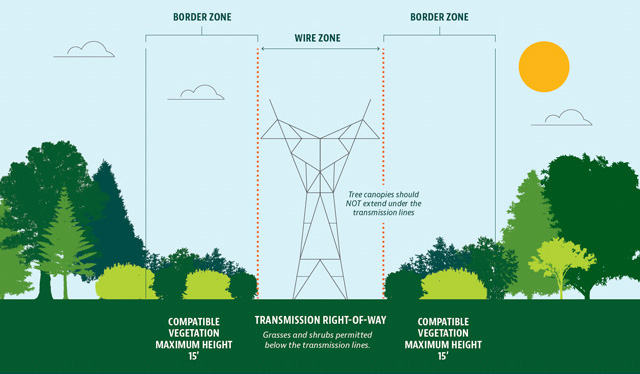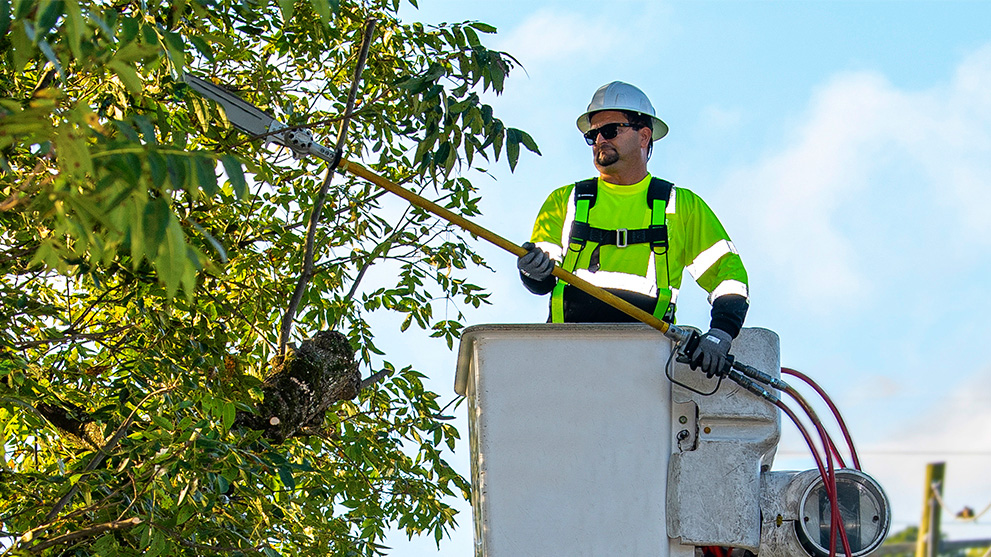In order to provide safe, reliable energy, we maintain and protect the rights-of-way under our power lines. This requires pruning and removing trees, cutting brush and applying herbicides to prevent vegetation from interrupting your service.
The Importance of Tree & Vegetation Management
The Northeast blackout of 2003
50 million people were left without power in one of the most dramatic power failures in history – due in part to a tree that made contact with high voltage power lines.
Vegetation management is crucial to limiting outages and quickly restoring service when they occur. By maintaining our rights-of-way, we can stop a lot of these problems before they start.
How we're preventing outages:
Residential Vegetation Management
We prune trees away from power lines on a planned cycle to reduce outages caused by downed trees or limbs. This lessens the threat of outages as well as providing easier access to our lines, which means quicker restoration of power in times of trouble. When pruning trees, we complete the entire line and do not schedule individual pruning requests.
Transmission Vegetation Management
We move electricity from generating sites to substations by a process called transmission. In order to bring the clean, safe, reliable, affordable energy that Georgians expect and deserve, we maintain vegetation on thousands of miles of transmission easements across the state.
Maintenance
Clear access to our rights-of-way is a key factor in restoring power quickly during an outage. We do this by keeping weeds and brush below a height that would hamper visibility or access. This can involve mowing or selectively applying commonly-used EPA-approved herbicides to non-desirable species.
Cyclical Pruning
We use industry standard methods to prune trees. By pruning lateral branches and using directional trimming to remove limbs at strong branches or the trunk, we protect the tree’s natural defense mechanisms that protect it from decay. This method removes branches at their natural shedding points, which reduces re-growth.
Planting Within an Easement
Generally, shrubs, gardens, grasses, and trees with a mature height of less than 15 feet are permitted on the easement area, as long as they don’t restrict access to the area and do not threaten the continued safe operation of the transmission line.
Mowing and Tree Removal
We typically mow once every six years to clear vegetation and redefine the easement. Property owners may mow more often if they desire. Once a year, all transmission lines are patrolled by air and ground to locate trees and other vegetation that pose a threat to transmission facilities.
Planting in Utility Right-of-Ways
Read our guidelines about

Frequently Asked Questions
Find the answers to all your questions.
Why prune trees, and how do you determine which trees to prune?
The need to prune a tree is based on its growth rate and proximity to a power line. Trees that come in contact with power lines are a major cause of outages. Small, slow-growing trees need less pruning than tall, fast-growing species. The farther a tree is from a power line easement, the less often it will have to be pruned.
Timely pruning to maintain adequate clearance between trees and power lines reduces outages, which improves the quality and reliability of electrical service. Safety is another reason to prune trees. Our customers, employees and contractors can be exposed to life-threatening risks if limbs touch lines and become energized.
How does Georgia Power have the right to access my property?
We have an obligation to maintain our electric facilities to provide safe and reliable electric service, as well as the right to enter and leave private property. We comply with the National Electric Safety Code (NESC) and other rules and regulations that govern the utility industry.
Typically, the easement agreements obtained by Georgia Power prior to construction of a transmission line include the right of ingress and egress to and from rights-of-way.
When is tree removal the best option?
Georgia Power may need to remove trees that are a risk to electrical service and public safety, particularly in cases involving repeated or severe pruning. When tree removal is the best option, we may provide a suitable low-growing replacement tree to the customer. Only low-growing species are permitted on defined width easements; tall-growing species are removed when found.
Why not mow the transmission rights-of-way more often?
In most cases, Georgia Power's transmission lines are built within easements across private property and are not owned by Georgia Power. Georgia Power periodically mows these easements to provide access to its facilities and to maintain acceptable vegetation on the rights-of-way. More frequent mowing to meet local ordinances, aesthetics or other requirements is the responsibility of the property owner.
Will I be allowed to place a swimming pool on the right-of-way?
Swimming pools are not permissible on the right-of-way. Please contact your local Right of Way Specialist before placing any permanent structures on the right of way.
Have more questions?
Have a question about trees and power lines, or the use of our easements?

